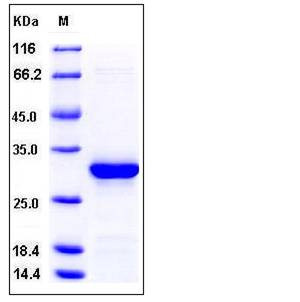Human Caspase-14 / CASP14 Protein (His Tag)
MGC119078, MGC119079
- 100ug (NPP1104) Please inquiry
| Catalog Number | P11856-H07E |
|---|---|
| Organism Species | Human |
| Host | E. coli |
| Synonyms | MGC119078, MGC119079 |
| Molecular Weight | The recombinant human CASP14 consisting of 248 amino acids and has a calculated molecular mass of 28.5 kDa. The apparent molecular mass of the protein is approximately 30 kDa in SDS-PAGE under reducing conditions. |
| predicted N | Met |
| SDS-PAGE |  |
| Purity | > 95 % as determined by SDS-PAGE |
| Protein Construction | A DNA sequence encoding the human CASP14 (NP_036246.1) (Ser 2-Gln 242) was expressed, with a polyhistide tag at the N-terminus. |
| Bio-activity | Measured by its ability to bind biotinylated Cynomolgus IL18 (P90011-C07E) in a functional ELISA. |
| Research Area | Immunology |Signal Transduction |Signaling Pathway |Representative pathway |Apoptosis Signaling pathway |Caspases and Regulators | |
| Formulation | Lyophilized from sterile PBS, pH 7.4 1. Normally 5 % - 8 % trehalose, mannitol and 0.01% Tween80 are added as protectants before lyophilization. Specific concentrations are included in the hardcopy of COA. |
| Background | Caspase 14 is a member of the caspase family. Caspases are a kind of cysteine proteinase consisting of a prodomain plus large and small catalytic subunits, that play a central role in cell apoptosis. Caspase 14 possesses an unusually short prodomain and is highly expressed in embryonic tissues but absent from most of the adult tissues except for the skin, which suggests a role in ontogenesis and skin physiology. Unlike the other short prodomain caspases(caspase-3, caspase-6, and caspase-7), Caspase 14 was not processed by multiple death stimuli including activation of members of the tumor necrosis factor receptor family and expression of proapaptotic members of the bcl-2 family. Caspase 14 has been described to be processed and activated by anti-Fas agonist antibody or TNF-related apoptosis inducing ligand in vivo. The expression and processing of this caspase may take part in keratinocyte terminal differentiation, which is essential for the skin barrier. |
| Reference |
